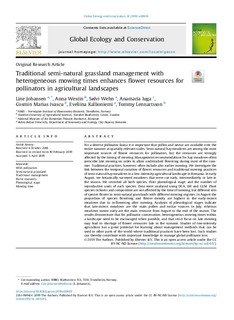| dc.contributor.author | Johansen, Line | |
| dc.contributor.author | Westin, Anna | |
| dc.contributor.author | Wehn, Sølvi | |
| dc.contributor.author | Iuga, Anamaria | |
| dc.contributor.author | Ivascu, Cosmin Marius | |
| dc.contributor.author | Kallioniemi, Eveliina | |
| dc.contributor.author | Lennartsson, Tommy | |
| dc.date.accessioned | 2019-09-05T11:26:04Z | |
| dc.date.available | 2019-09-05T11:26:04Z | |
| dc.date.created | 2019-08-14T10:06:31Z | |
| dc.date.issued | 2019 | |
| dc.identifier.issn | 2351-9894 | |
| dc.identifier.uri | http://hdl.handle.net/11250/2612648 | |
| dc.description.abstract | For a diverse pollinator fauna it is important that pollen and nectar are available over the entire summer at spatially relevant scales. Semi-natural hay meadows are among the most important sources of flower resources for pollinators, but the resources are strongly affected by the timing of mowing. Management recommendations for hay meadows often prescribe late mowing on order to allow undisturbed flowering during most of the summer. Traditional practices, however, often include also earlier mowing. We investigate the link between the temporal variation of flower resources and traditional mowing practices of semi-natural hay meadows in a low-intensity agricultural landscape in Romania. In early August, we botanically surveyed meadows that were cut early, intermediately, or late in the season. We recorded all herb species, their phenological stage, and the number of reproductive units of each species. Data were analysed using DCA, LM and GLM. Plant species richness and composition are not affected by the time of mowing, but different sets of species flower in semi-natural grasslands with different mowing regimes. In August the proportion of species flowering and flower density are highest in the early-mown meadows due to re-flowering after mowing. Analyses of phenological stages indicate that late-mown meadows are the main pollen and nectar sources in July, whereas meadows mown early are the main resource from August to the end of the season. The results demonstrate that for pollinator conservation, heterogeneous mowing times within a landscape need to be encouraged when possible, and that strict focus on late mowing may lead to shortage of flower resources late in the summer. Studies of low-intensity agriculture has a great potential for learning about management methods that can be used in other parts of the world where traditional practices have been lost. Such studies can thereby contribute with important knowledge to manage global pollinator loss. | nb_NO |
| dc.language.iso | eng | nb_NO |
| dc.rights | Attribution-NonCommercial-NoDerivatives 4.0 Internasjonal | * |
| dc.rights.uri | http://creativecommons.org/licenses/by-nc-nd/4.0/deed.no | * |
| dc.subject | Wild pollinators | nb_NO |
| dc.subject | Semi-natural grassland | nb_NO |
| dc.subject | Traditional management | nb_NO |
| dc.subject | Floral resources | nb_NO |
| dc.subject | Phenological stage | nb_NO |
| dc.subject | Mowing time | nb_NO |
| dc.title | Traditional semi-natural grassland management with heterogeneous mowing times enhances flower resources for pollinators in agricultural landscapes | nb_NO |
| dc.type | Journal article | nb_NO |
| dc.type | Peer reviewed | nb_NO |
| dc.description.version | publishedVersion | nb_NO |
| dc.rights.holder | © 2019 The Authors. | nb_NO |
| dc.subject.nsi | VDP::Landbruks- og Fiskerifag: 900 | nb_NO |
| dc.source.volume | 18 | nb_NO |
| dc.source.journal | Global Ecology and Conservation | nb_NO |
| dc.identifier.doi | 10.1016/j.gecco.2019.e00619 | |
| dc.identifier.cristin | 1715793 | |
| dc.relation.project | Norges forskningsråd: 230278 | nb_NO |
| dc.relation.project | Norges forskningsråd: 280715 | nb_NO |
| cristin.unitcode | 7677,1,0,0 | |
| cristin.unitname | Divisjon for matproduksjon og samfunn | |
| cristin.ispublished | true | |
| cristin.fulltext | original | |
| cristin.qualitycode | 1 | |

